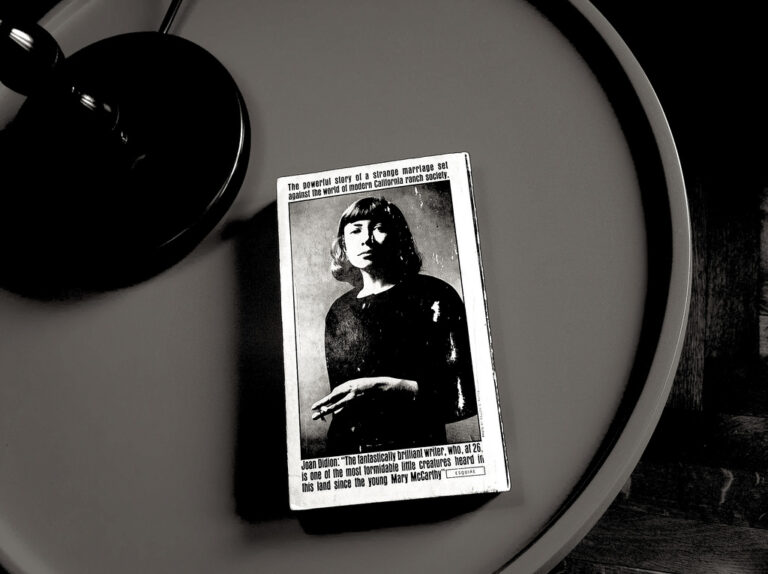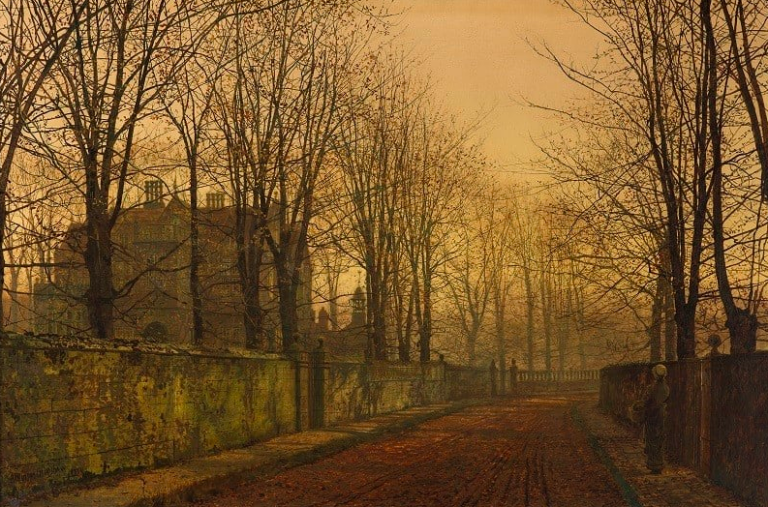Joan Didion and the Always Apocalypse

I live near a regional airport, so it’s not uncommon to see and hear planes flying at what I consider to be worryingly low altitudes. When I see them passing over rooftops or hear the shriek of the engines while lying in bed at night, the question of what would happen if those engines gave out is never far away. Logically, I know a crash is unlikely, but growing up has taught me that logic is not always the governing principle I thought it would be. Joan Didion describes a similar feeling in “In the Islands,” part of her second essay collection, The White Album, but connects her feelings of helplessness with a larger disillusionment. Stuck in a Hawai’ian hotel “waiting for a tidal wave that will not come,” she tells readers that they “are getting a woman who somewhere along the line misplaced whatever slight faith she ever had . . . in the whole grand pattern of human endeavor.”
The White Album, published in 1979, and its 1968 predecessor, Slouching Towards Bethlehem, established Didion as an important voice in American cultural criticism, and introduced readers to her precise social analysis, sharpened by what others have called her “hostile acts of observation”—a knowledge “that nothing is as special as it seemed,” and that the world as she thought she knew it is rapidly coming to a close. Seeing Didion as a prophet of the cultural breakdown of the sixties is nothing new, but what strikes me is the anticipatory nature of her essays. The William Butler Yeats poem “The Second Coming,” which gives Slouching Towards Bethlehem its title, foreshadows this. “Things fall apart; the centre cannot hold,” it reads. So for now the center is still intact. But it doesn’t have much longer, and the catastrophic collapse of society and moral meaning that will be the fallout is the horror the two essay collections anticipate, even though, like the tidal wave in Hawai‘i, this collapse may never actually occur.
Reading Slouching Towards Bethlehem and The White Album, I came to think of this queasy expectancy as an unrealized, or always, apocalypse. In the preface of Slouching Towards Bethlehem, Didion writes that she found it “necessary…to come to terms with disorder” in order to continue her writing, but it’s hard to square her wary tone with anything so settled as a coming-to-terms. Instead, her books teeter over a precipice, seeing the rocks at the bottom and grimly awaiting the final push. However dire the current landscape may be, Didion sees it as a precursor instead of an end, and finding some way of coping with the possibility of eminent collapse is no less important because that collapse hovers just out of reach.
The potential for this collapse is rooted in the slipperiness of the sixties psyche, which Didion interprets as having an increasingly introspective, indifferent bent that alienates itself from any of the forces—like society, education, or meaningful conflict—that might draw it into the stabilizing web of society. This “atomization” is proof that the crass romanticism of the American dream has succeeded far beyond terms of prudence or objective reality. As she writes in “Some Dreamers of the Golden Dream,” a mixture of essay and reportage on the murder trial of Lucille Miller, “the dream was teaching the dreamers how to live.” This sickening overabundance is hammered home in title essay of The White Album, in which Didion, quoting extensively from her own psychiatric report, remarks that an “attack of vertigo and nausea does not now seem to me an inappropriate response to the summer of 1968.” The decade is harried, its unrest stoked to boiling point and ready to tip into anarchic chaos at any moment.
What stays this final tip of the scales from uneasy equilibrium to disorder is the same apathy that brought it about. The hippie movements grouped around Haight-Ashbury must disintegrate because, in spite of their poignant anti-establishment pretensions, “they feed back exactly what is given them” with no ideological structure of their own. The California community’s response to the Tate-LaBianca murders is equally unmoored, with Didion haunted by the sense of inevitability the news of the crime evinced. Even developments like the women’s movement, which would seem at first glance to have a defined shape, are bogged down in a longing for the novelty of a new life without thought for the larger picture. This naïve individualism is what keeps society on the edge of larger disaster, breeding the disorder Didion pushes against.
The two collections can be read as quest narratives, attempts to plot a moral course when previous avenues of meaning collapse. Didion doesn’t immediately spring to mind when thinking about great moral writers, particularly since she herself is highly suspicious of conventional morality. “It is difficult to believe that ‘the good’ is a knowable quantity,” she writes, concluding that only definitions that stick to basic communal survival have much chance of being effective. This wariness shouldn’t overshadow the moral nature of her work, which is piercing but never contemptuous, and deeply concerned with the question of living, and living rightly, in an environment where personal and intellectual purity are impossible.
If there is any redemptive approach readers would expect Didion to stake her claim on, it is writing, but her belief in its power is far from unqualified. “We tell ourselves stories in order to live,” which opens “The White Album,” is one of the essay’s most quoted lines, and it’s sometimes tempting to forget the let-down that follows: “I am talking here about a time when I began to doubt the premises of all the stories I had ever told.” The act of writing, after all, can lead to the same inward-seeking ennui she saw in Haight-Ashbury. In “On Keeping a Notebook,” she writes that “How it felt to me” is the true reason she records thoughts and observations, and readers can feel the discomfort surrounding that statement. Later in the same essay, she writes that “the common denominator of all we see is always, transparently, shamelessly, the implacable ‘I.’” Uncomfortable as she may be with the inward tendencies of the writer’s work, she is just as much a product of the time as the teenage runaways and dissatisfied housewives she covers. The only difference is that she is able to recognize that her “inaccessible places of the mind” are just that, and not a reflection of objective reality.
Didion is more interested in observing the always apocalypse than she is in suggesting solutions for it. This position is part and parcel of her moral vision that attention is imperative and caution even more so. Her painstaking analysis of all of the ways in which our powers of observation fail us doesn’t destroy her conviction that such observation is important. Slouching Towards Bethlehem and The White Album show that there is a story even in the lack of a story: with the passage of time, even the confusion of the sixties has become a cultural shorthand, the jaggedness of its edges sanded down to become part of America’s myths of its own history. Didion could have predicted this turn of events, and the impossibility of stopping it. Her two collections act as a corrective to the optimism of the present and the romanticism of the future.
That this corrective may seem timid falls in line with Didion’s distrust of extremism in any form. Her writing works on an individual level, planting seeds of doubt that also emphasize the compassion of clear-eyed reporting and the dangers of self-assuredness. To return to the Yeats poem, it seems that Didion truly believes that “The best lack all conviction, while the worst / Are full of passionate intensity.” It’s far from a battle cry against disorder, but it is also the only closure she is able to give.


